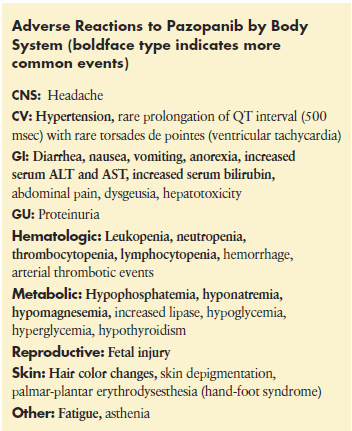Pazopanib, a Multitargeted Tyrosine Kinase Inhibitor for Advanced Renal Cell Cancer
Approved Drugs: Pazopanib (Votrient) Indications
Approved Drugs: Pazopanib (Votrient)Indications
Treatment of patients with advanced renal cell cancer.
Mechanism of Action
Prevents angiogenesis (new blood vessels), and growth of some tumors. It is a multitargeted tyrosine kinase inhibitor of:
•Vascular endothelial growth factor receptor 1,2,3 (VEGFR-1,2,3)
• Platelet derived growth factor receptor (PDGFR)-α and β
• Fibroblast growth factor receptor (FGF)-1,3
• Cytokine receptor (Kit)
• Interleukin-2 (IL-2) receptor inducible T-cell kinase (Itk)
• Leucocyte-specific protein tyrosine kinase (Lck)

Metabolism
Following oral dosing, drug reaches peak plasma concentration in 2–4 hours. If tablet is crushed rather than swallowed whole, bioavailability and area under the curve (AUC) serum level are increased by 46%. Administration with high-fat meal also increases AUC, so a whole tablet should be taken on an empty stomach. Drug is primarily metabolized by CYP3A4 hepatic enzyme system, and to a minor degree by CYP1A2 and CYP2C8. Drug mean half-life is 30.9 hours after administration. Drug is eliminated in the feces, and to a lesser degree in the urine. If patient has moderate hepatic impairment, drug clearance is reduced by 50%, so drug dose should be reduced in these patients.
Drug Administration
• Pazopanib 800 mg orally once daily without food (at least 1 hour before or 2 hours after a meal).
• Drug dose in moderate hepatic impairment is 200 mg orally without food.
• Drug is not recommended for patients with severe hepatic impairment, defined as total bilirubin > 3 × upper limit of normal (ULN) with any level of alanine transaminase (ALT).
• Coadministration of strong CYP3A4 inhibitor (eg, ketoconazole, ritonavir, clarithromycin): Reduce dose of pazopanib to 400 mg orally once daily without food, but may need further dose reduction if side effects are severe.
• Patients who require concomitant chronic administration of strong CYP3A4 inducer medication should not take pazopanib.
• Available as 200- and 400-mg tablets.
Patient Education
• Drug may cause changes in liver and bile blood chemistry results so patient’s blood will be monitored closely (liver function tests) before starting therapy, and at least every 4 weeks for the first 4 months of therapy, or more frequently if needed.
• Drug may cause loss of pigment in the hair strands (depigmentation) during treatment, which will return to normal once the drug is stopped.
• It is very important to take the medicine on an empty stomach; if taken with food, this may increase the drug side effects.
• Rarely, severe and possibly fatal liver damage may occur. Patient should call doctor right away if s/he experiences any of the following: yellowing of the skin or whites of the eyes; unusual darkening of the urine; unusual tiredness; pain in the right upper part of abdomen.
• Women of child-bearing potential should use effective birth control measures to prevent pregnancy, as the drug may harm the fetus. Mothers should not nurse while receiving the drug.
Drug Interactions
• CYP3A4 inhibitors (strong, eg, ketoconazole, ritonavir, clarithromycin, grapefruit or juice): may increase the plasma pazopanib concentration. Avoid coadministration. (For more information, see ONCOLOGY Nurse Edition 22(11):33,52–56, February 2009.) If coadministration is necessary, consider a dose reduction of pazopanib.
• CYP3A4 inducers (strong, eg, rifampin): may decrease the plasma concentration of pazopanib. Avoid coadministration.
• Substrates of CYP3A4, CYP2D6, CYP2C8 with a narrow dose range: Do not coadminister, as the drug metabolism may be inhibited resulting in serious side effects from the coadministered drug.
Special Considerations
• Consider tumor lysis prevention with allopurinol.
• Increases in BP may occur and are related to steady-state drug plasma concentrations.
• Drug may rarely prolong QTc interval, increasing the risk of ventricular tachycardia (torsades de pointes).
• If patient develops diarrhea, s/he should follow the instructions given by the doctor or nurse. Patient should report diarrhea that is moderate to severe or does not stop within 24 hours.
Contraindications/Precautions
• Severe and fatal hepatotoxiciy may occur. Monitor liver function tests (LFTs) at baseline, then at least monthly for the first 4 months, and then regularly during therapy.
Elevation of the transaminases (ALT, aspartate transaminase [AST]) occurs in the first 18 weeks of therapy.
• If ALT is increased to 3 × ULN – 8 × ULN, pazopanib can be continued with weekly monitoring of LFT until ALT returns to Grade 1 or baseline.
• If ALT is increased > 8 × ULN, pazopanib should be interrupted. If the potential benefit of the drug outweighs the risk, pazopanib can be reintroduced at 400 mg orally once daily, or a lower dose, with weekly monitoring of LFTs for 8 weeks. If after reintroduction, ALT increases to > 3 × ULN again, the drug should be discontinued.
• If ALT is increased > 3 × ULN together with an
increased bilirubin > 2 × ULN, pazopanib should be permanently discontinued.
• Use drug cautiously in patients with Gilbert’s syndrome, as drug is a UGT1A1 inhibitor. UGT1A1 is a glucuronidation enzyme that is inefficient in patients with Gilbert’s syndrome, resulting in an elevated level of bilirubin (indirect or unconjugated hyperbilirubinemia).
• Drug can prolong the QT interval (period of ventricular depolarization) 500 msec, which increases the risk of torsades de pointes (type of ventricular tachycardia). Risk is increased in patients taking other drugs that prolong the QT interval (eg, antiarrhythmics), and/or who have pre-existing cardiac disease, hypomagnesemia, hypocalcemia, and hypokalemia. Patients should have a baseline EKG with QTc determination, and it should be repeated during therapy. In addition, baseline electrolytes should be determined, any abnormalities corrected before therapy begins, and electrolytes monitored closely during therapy.
• Antiangiogenic class effects may occur.
• Hemorrhage may occur (16% all grades, 2% grades 3–5), and may be rarely fatal. Patients with a history of hemoptysis, cerebral, or significant GI hemorrhage within the last 6 months should not receive pazopanib.
• Arterial thrombotic events may rarely occur (3% all grades, 2% grades 3–5), manifested as myocardial infarction, angina, ischemic stroke, or transient ischemic attack. Drug should be used cautiously in patients who are at higher risk for these events, and should not be used in patients who have had an event within the previous
6 months.
• Rarely, GI perforation or fistula can occur (0.9%) and patients should be monitored closely for signs and symptoms.
• Hypertension occurs in 40% of patients, so it should be well-controlled prior to starting pazopanib therapy; 88% of patients who developed hypertension did so early, within the first 18 weeks of therapy. If hypertension persists despite antihypertensive therapy, the dose of pazopanib may be reduced. The drug should be stopped if severe hypertension persists on antihypertensive therapy and after pazopanib dose reduction.
• Wound healing may be impaired, although no studies have been done. Pazopanib should be stopped at least
7 days before scheduled surgery, and resumption of drug should be based on extent of adequate wound healing. Drug should be discontinued if wound dehiscence occurs.
• Hypothyroidism occurs in 4% of patients, so monitoring of thyroid function tests is recommended.
• Proteinuria may occur in 8% of patients. Assess baseline urinalysis and repeat periodically during therapy.
